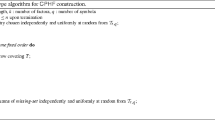Abstract
The classical orthogonal arrays over the finite field underlie a powerful construction of perfect hash families. By forbidding certain sets of configurations from arising in these orthogonal arrays, this construction yields previously unknown perfect, separating, and distributing hash families. When the strength s of the orthogonal array, the strength t of the hash family, and the number of its rows are all specified, the forbidden sets of configurations can be determined explicitly. Each forbidden set leads to a set of equations that must simultaneously hold. Hence computational techniques can be used to determine sufficient conditions for a perfect, separating, and distributing hash family to exist. In this paper the forbidden configurations, resulting equations, and existence results are determined when (s, t) ∈ {(2, 5), (2, 6), (3, 4), (4, 3)}. Applications to the existence of covering arrays of strength at most six are presented.
Similar content being viewed by others
References
Barwick S.G., Jackson W.-A.: A sequence approach to linear perfect hash families. Des. Codes Cryptogr. 45(1), 95–121 (2007)
Barwick S.G., Jackson W.-A.: Geometric constructions of optimal linear perfect hash families. Finite Fields Appl. 14(1), 1–13 (2008)
Barwick S.G., Jackson W.-A., Quinn C.T.: Optimal linear perfect hash families with small parameters. J. Combin. Des. 12(5), 311–324 (2004)
Bierbrauer J., Schellwat H.: Almost independent and weakly biased arrays: efficient constructions and cryptologic applications. Lect. Notes Comput. Sci. 1880, 533–543 (2000)
Blackburn S.R.: Perfect hash families: probabilistic methods and explicit constructions. J. Combin. Theory A 92, 54–60 (2000)
Blackburn S.R., Wild P.R.: Optimal linear perfect hash families. J. Combin. Theory Ser. A 83(2), 233–250 (1998)
Blackburn S.R., Burmester M., Desmedt Y., Wild P.R.: Efficient multiplicative sharing schemes. Lect. Notes Comput. Sci. 1070, 107–118 (1996)
Chateauneuf M.A., Kreher D.L.: On the state of strength-three covering arrays. J. Combin. Des. 10(4), 217–238 (2002)
Cohen D.M., Dalal S.R., Fredman M.L., Patton G.C.: The AETG system: an approach to testing based on combinatorial design. IEEE Trans. Softw. Eng. 23(7), 437–44 (1997)
Colbourn C.J.: Combinatorial aspects of covering arrays. Le Matematiche (Catania) 58, 121–167 (2004)
Colbourn C.J.: Covering array tables. http://www.public.asu.edu/~ccolbou/src/tabby,2005-present.
Colbourn C.J.: Distributing hash families and covering arrays. J. Combin. Inf. Syst. Sci. (to appear).
Colbourn C.J., Dinitz J.H.: Mutually orthogonal latin squares: a brief survey of constructions. J. Stat. Plan. Inference 95, 9–48 (2001)
Colbourn, C.J., Dinitz, J.H. (eds): The CRC Handbook of Combinatorial Designs, 2nd edn. Chapman and Hall/CRC, Boca Raton (2007)
Colbourn C.J., Martirosyan S.S., van Trung T., Walker R.A. II: Roux-type constructions for covering arrays of strengths three and four. Des. Codes Cryptogr. 41, 33–57 (2006)
Dinitz J.H., Ling A.C.H., Stinson D.R.: Perfect hash families from transversal designs. Australas. J. Combin. 37, 233–242 (2007)
Fiat A., Naor M.: Broadcast encryption. Lect. Notes Comput. Sci. 773, 480–491 (1994)
Hartman A.: Software and hardware testing using combinatorial covering suites. In: Golumbic, M.C., Hartman, I.B.-A. (eds) Interdisciplinary Applications of Graph Theory, Combinatorics, and Algorithms, pp. 237–266. Springer, Norwell (2005)
Hartman A., Raskin L.: Problems and algorithms for covering arrays. Discrete Math. 284(1–3), 149–156 (2004)
Hedayat A.S., Sloane N.J.A., Stufken J.: Orthogonal Arrays. Springer-Verlag, New York (1999)
Martirosyan S.S., van Trung T.: On t-covering arrays. Des. Codes Cryptogr. 32(1–3), 323–339 (2004)
Martirosyan S.S., van Trung T.: Explicit constructions for perfect hash families. Des. Codes Cryptogr. 46(1), 97–112 (2008)
Mehlhorn K.: Data Structures and Algorithms 1: Sorting and Searching. Springer-Verlag, Berlin (1984)
Sarkar P., Stinson D.R.: Frameproof and IPP codes. In: Progress in Cryptology—INDOCRYPT 2001 (Chennai), vol. 2247 of Lecture Notes in Computer Science, pp. 117–126. Springer, Berlin (2001).
Soriano P.P.: Private communication by e-mail (March 2008).
Stinson D.R., van Trung T., Wei R.: Secure frameproof codes, key distribution patterns, group testing algorithms and related structures. J. Stat. Plan. Inference 86, 595–617 (2000)
Turán P.: Eine Extremalaufgabe aus der Graphentheorie. Mat. Fiz. Lapok 48, 436–452 (1941)
Walker R.A. II, Colbourn C.J.: Perfect hash families: constructions and existence. J. Math. Crypt. 1, 125–150 (2007)
Author information
Authors and Affiliations
Corresponding author
Additional information
Communicated by P. Wild.
Rights and permissions
About this article
Cite this article
Colbourn, C.J., Ling, A.C.H. Linear hash families and forbidden configurations. Des. Codes Cryptogr. 52, 25–55 (2009). https://doi.org/10.1007/s10623-008-9266-7
Received:
Revised:
Accepted:
Published:
Issue Date:
DOI: https://doi.org/10.1007/s10623-008-9266-7




